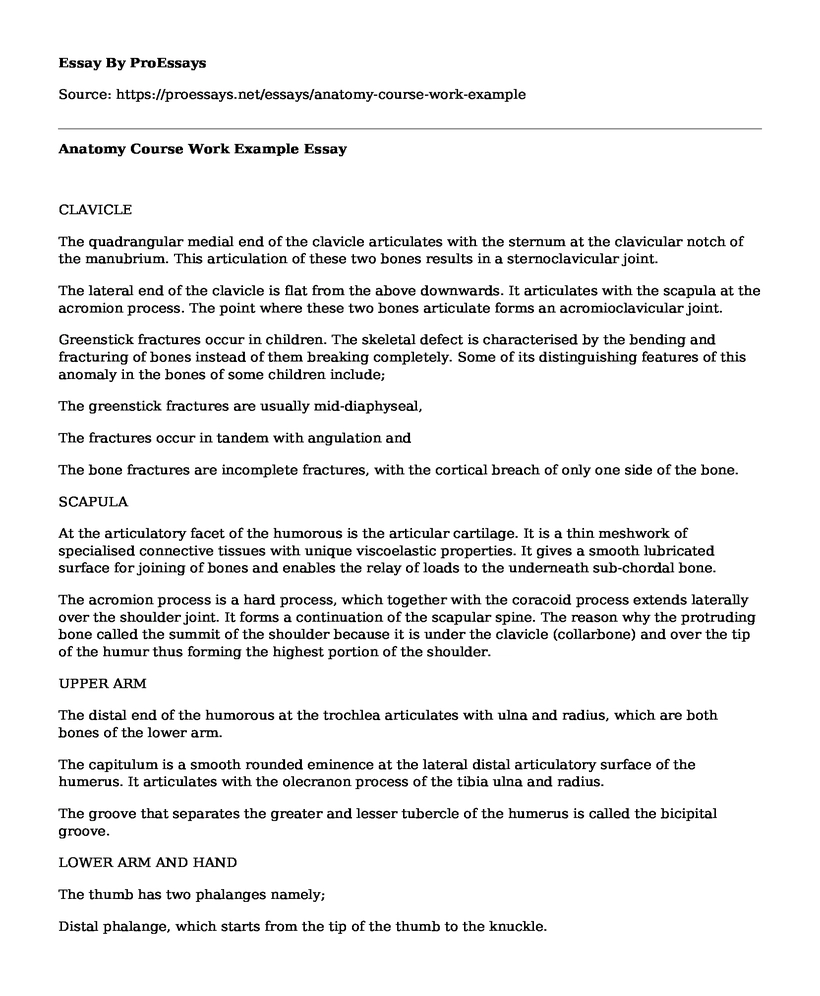CLAVICLE
The quadrangular medial end of the clavicle articulates with the sternum at the clavicular notch of the manubrium. This articulation of these two bones results in a sternoclavicular joint.
The lateral end of the clavicle is flat from the above downwards. It articulates with the scapula at the acromion process. The point where these two bones articulate forms an acromioclavicular joint.
Greenstick fractures occur in children. The skeletal defect is characterised by the bending and fracturing of bones instead of them breaking completely. Some of its distinguishing features of this anomaly in the bones of some children include;
The greenstick fractures are usually mid-diaphyseal,
The fractures occur in tandem with angulation and
The bone fractures are incomplete fractures, with the cortical breach of only one side of the bone.
SCAPULA
At the articulatory facet of the humorous is the articular cartilage. It is a thin meshwork of specialised connective tissues with unique viscoelastic properties. It gives a smooth lubricated surface for joining of bones and enables the relay of loads to the underneath sub-chordal bone.
The acromion process is a hard process, which together with the coracoid process extends laterally over the shoulder joint. It forms a continuation of the scapular spine. The reason why the protruding bone called the summit of the shoulder because it is under the clavicle (collarbone) and over the tip of the humur thus forming the highest portion of the shoulder.
UPPER ARM
The distal end of the humorous at the trochlea articulates with ulna and radius, which are both bones of the lower arm.
The capitulum is a smooth rounded eminence at the lateral distal articulatory surface of the humerus. It articulates with the olecranon process of the tibia ulna and radius.
The groove that separates the greater and lesser tubercle of the humerus is called the bicipital groove.
LOWER ARM AND HAND
The thumb has two phalanges namely;
Distal phalange, which starts from the tip of the thumb to the knuckle.
Proximal Phalange, which proceeds from the finger to the base of the thumb.
The carpal bones anatomically occur in three longitudinal columns. The visible bones carpal bones are ten (10).
The human wrist can make a pair of movements making the palm to face up and down. This pair of processes is called pronation and supination. During supination, the radius rolls around the ulna bone at the wrist and the elbow. This movement makes the radius and ulna appear crossed.
UPPER LEG
The femur is the longest and heaviest bone in the body. Its approximate length is between one-third and one-fourth of that of the body hence a point for estimating stature. When a person is standing, the femur transmits weight to the tibia from the femur. It has enough supply of muscles making both its superior and inferior ends palpable.
The lower extremity of the femur is characteristically larger than the upper part. At the lower limb, the femur articulates with tibia and patella at the knee forming a synovial joint.
Cite this page
Anatomy Course Work Example. (2021, Apr 20). Retrieved from https://proessays.net/essays/anatomy-course-work-example
If you are the original author of this essay and no longer wish to have it published on the ProEssays website, please click below to request its removal:
- Dow Corning Company Case Study Paper Example
- Essay Sample on Similarities and Differences Between a Sheep and a Fetal Pig Heart
- Sight Sense - Essay Sample
- Genetics in Treating and Developing Cancer Paper Example
- Paper Example on Sharks & Teleosts: Similarities & Differences
- Essay Sample on 3 Sections of the Brain: Cerebrum, Brain Stem, & Cranial Nerves
- Paper Example on Hyaline Cartilage







